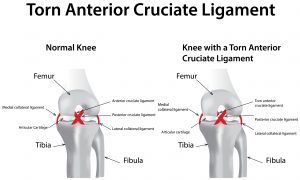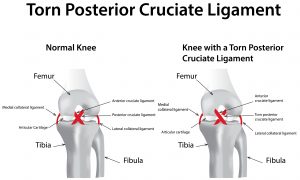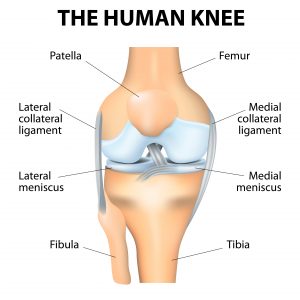Common Knee Ligament Problems
Posted by Phil Heler on January 5, 2016Common ligament problems in the knee include injuries to the ACL (anterior cruciate ligament), the PCL (posterior cruciate ligament) and the collateral ligaments.
Anterior cruciate ligament
Typical symptoms: ACL injuries usually present as an unstable knee following an obvious trauma. Injuries present with significant swelling, intense pain on weight bearing (this will vary depending on the severity of the forces involved in the injury).
The bony structures of your knee comprise the femur (thigh bone) and tibia (shin bone) that act like a simple hinge and a third small bone called the patella (or knee cap). The femur and tibia are held in place by four main ligaments. Two of these are the collateral ligaments (medial and lateral) and the third and fourth are the posterior cruciate ligament (PCL) with the ACL.
The ACL runs diagonally in the middle of the knee, preventing the tibia from sliding out in front of the femur, as well as providing rotational stability to your knee. Often ACL injuries will also occur in combination with damage to other structures such as the meniscus (shock absorbers in the knee) in 50% of cases and collateral ligaments in 30% of cases and also articular cartilage in the joint (roughly 30% of cases).
One of the worst injuries is the ‘unhappy triad’, common in footballers or skiers, where injury is sustained to the ACL, medial collateral ligament and meniscus.
Minor ACL tears have a relatively good outcome and may require up to three months of careful rehabilitation although careful continued monitoring is required in order to assess knee stability.
Complete ACL ruptures or larger tears have a less favourable outcome and probably require surgical reconstruction.
Posterior cruciate ligament
Typical symptoms: PCL injuries usually present an unstable knee after an obvious trauma. Injuries present with significant swelling, intense pain on weight bearing (this will vary depending on the severity of the forces involved in the injury).
The bony structures of your knee comprise the femur (thigh bone) and tibia (shin bone) that act like a simple hinge and a third small bone called the patella (or knee cap). The femur and tibia are held in place by four main ligaments. Two of these are the collateral ligaments (medial and lateral) and the third is the posterior cruciate ligament (PCL) with the ACL being the fourth.
The incidence of injuries of the PCL is less than that of the ACL due to its greater thickness and strength. Nevertheless, the most common way in which the PCL is injured is by direct impact to the front of the shinbone, usually when the knee is bent or flexed. This may occur in a front-on tackle or collision or when falling with the knee bent.
The injury is usually associated with injuries to other structures at the back of the knee joint because of the forces involved (usually a meniscus tear). Like all ligament tears, PCL tears are graded 1 to 3 with level 3 being the most severe. These are classified depending on the amount of backward tibial displacement observed when the knee is bent at 90 degrees. In extreme cases, the ligament may become avulsed or pulled away from the bone completely.
Minor PCL tears have a relatively good outcome and may require up to three months of careful rehabilitation although careful continued monitoring is required in order to assess knee stability.
Complete PCL ruptures or larger tears have a less favourable outcome and probably require surgical reconstruction.
Collateral ligaments
Typical symptoms: Pain at the side of the knee with swelling and possible instability with a severe sprain.
Medial (or inside) collateral ligament (MCL) and lateral (or outside) collateral ligament (LCL) injuries are very common and normally less traumatic than PCL or ACL injuries unless they occur as an addition to these injuries. In fact, injuries to the MCL especially are one of the most common ligamentous knee injury we see.
These ligaments are found on the sides of your knee. The LCL connects your thigh bone (or femur) to the smaller bone on the outside of your lower leg (fibula) and the MCL connects the femur to larger bone on the inside of your lower leg (the tibia). The MCL and LCL fundamentally stop sideways movements in either direction.
These ligaments can be strained as either a Grade 1 (slightly stretched but still stable) or Grade 2 (becomes loose) or Grade 3 (complete tear with an unstable knee). A force that pushes the knee sideways often causes injuries to the collateral ligaments. These are often contact injuries, but not always. Injuries will naturally result in pain at the side of the knee, swelling at the site of injury and a degree of instability depending on the severity.
In the case of a mild injury, the only treatment required may be wearing a compression bandage to support the knee. In the case of more serious injuries, the patient may be required to wear a splint on the knee for five to six weeks. The splint will allow the knee to be bent or extended, but braces in the splint will prevent the knee from moving from side to side.


